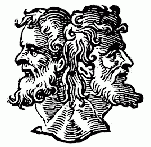
The Greek Anthology is a series of cycles of Greek lyric and epigrammatic poems by scores of writers both ancient and medieval Christian, assembled in a series of collections from antiquity onwards. One form of the Anthology had been rediscovered in the 15th century and was first published in Florence in 1494 by Janus Lascaris, a well-known Hellenist. This version, known as the Planudean text, had been assembled by a monk named Maximus Planudes at the very end of the 13th century. A later, larger, and more authoritative text, based on a 10th-century manuscript formerly in the library of the Count Palatine at Heidelberg, was published only in 1616. The Palatine text forms the basis of modern editions (though the Planudean text contains a large number of poems not found in the Palatine ms).
Like most scholars interested in Greek literature, Alciato was fascinated by the Planudean Greek Anthology and in the early 1520's he began to work on the poems. In 1529 he had 153 of his translations published in an edition by Janus Cornarius of Selecta epigrammata Graeca Latine versa, ex septem Epigrammatum Graecorum libris (Select epigrams translated from Greek to Latin, taken from the seven books of Greek epigrams). The kind of poetry found in the Anthology -- often a poetry of riddling ambiguity and moral instruction -- was to lay the basis for Alciato's emblems.
Of the 104 emblems in the first unauthorized edition of Alciato's Emblematum liber (1531), 31 were based on poems from the Greek Anthology. In later editions, the debt grew. For a tabulation, see the list by Denis Drysdall on the Glasgow emblem site.
Below we list 46 emblems that show some kind of close relationship to poems in the Anthology. These emblems are linked to modern English translations. Because the English is based on a later version of the Greek text than that used by Alciato, there may be some differences. But you will at least be able to see in general terms the kind of ways Alciato adapted the Anthology in order to make his Book of Emblems.